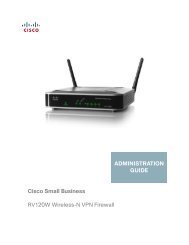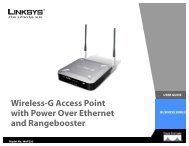Cisco Catalyst 6500 Supervisor 2T Architecture - Ipland
Cisco Catalyst 6500 Supervisor 2T Architecture - Ipland
Cisco Catalyst 6500 Supervisor 2T Architecture - Ipland
You also want an ePaper? Increase the reach of your titles
YUMPU automatically turns print PDFs into web optimized ePapers that Google loves.
White Paper6. Additional lookups may be performed by the fabric interface and replication ASIC (if this packet needsreplication services, such as SPAN, multicast, and others).7. The packet is then forwarded to the egress port ASIC (if the destination is local), or to the switch fabric (if thedestination is a port on a remote fabric-capable linecard), or to the bus replication ASIC (if the packetdestination is a linecard with connectivity only to the bus).Egress Packet Processing (Packets Received from Crossbar)1. Packets are received from one of the switch fabric channels.2. The switch fabric sends the packet to the fabric replication ASIC.3. The fabric replication ASIC stores the packet and sends the packet header information to the PFC4 forforwarding lookup processing.4. The PFC4 performs the lookup and sends the results back to the fabric replication ASIC.5. The fabric replication ASIC performs an additional lookup, if replication services are required.6. The fabric replication ASIC then forwards the packet (and replicated packets, if applicable) to the port ASIC,which contains destination information from PFC4.7. The port ASIC stores the packet in the packet buffer and performs egress checks on the packet.8. The port ASIC performs the packet rewrite and then forwards the packet to the CTS ASIC.9. If CTS is enabled, the CTS ASIC performs 802.1ae encryption, and the packet is forwarded to the PhysicalLayer Protocol (PHY), to be transmitted onto the cable.Egress Packet Processing (Packets Received from Shared Bus)1. Packets are received from the bus and are placed on the local bus.2. The Bus Replication ASIC stores the packet and sends packet header information to the PFC4 for forwardinglookup processing.3. The PFC4 performs the lookup and sends the results back to the bus replication ASIC.4. The bus replication ASIC performs an additional lookup, if replication services are required.5. The bus replication ASIC forwards the packet (and replicated packets, if applicable) to the port ASIC, whichcontains destination information from PFC4.6. The port ASIC stores the packet in the packet buffer, and performs egress checks on the packet.7. The port ASIC performs the packet rewrite and forwards the packet to CTS ASIC.8. If CTS is enabled, the CTS ASIC performs 802.1ae encryption, and the packet is forwarded to the PHY, to betransmitted onto the cable.The following sections provide more detail for each processing block.The Fabric and Bus ConnectorThe <strong>Catalyst</strong> <strong>6500</strong> supports two different switch backplanes, the crossbar switch fabric (top left in the abovediagram), and bus backplanes (top right in the above diagram). The crossbar switch fabric is the high-capacitybackplane that is used by the CEF720 and CEF<strong>2T</strong> generation of linecards to optimize switching performance. Thisbackplane refers to the 2 Terabit backplane that is contained within the <strong>Supervisor</strong>’s name. A second backplane(referred to as the “bus” backplane) is also present to support WS-X61xx linecards, supported service modules, andlinecards that do not utilize a local DFC4 for forwarding.The crossbar switch fabric provides a set of fabric channels (or data paths) that are assigned to the slots in thechassis where linecards are inserted. This is referred to collectively as the crossbar switch backplane. This array of© 2011-2012 <strong>Cisco</strong> and/or its affiliates. All rights reserved. This document is <strong>Cisco</strong> Partner Confidential Information. Page 10 of 46

















